📒 程序员小王的博客:(https://www.wolai.com/wnaghengjie/ahNwvAUPG2Hb1Sy7Z8waaF)
🎉 ?欢迎点赞 👍 收藏 ?留言 📝?
😊 ?如有编辑错误联系作者,如果有比较好的文章欢迎分享给我,我会取其精华去其糟粕
一、ORM思想
1、原始JDBC操作数据库出现的问题
-
操作繁琐
-
占位符赋值麻烦
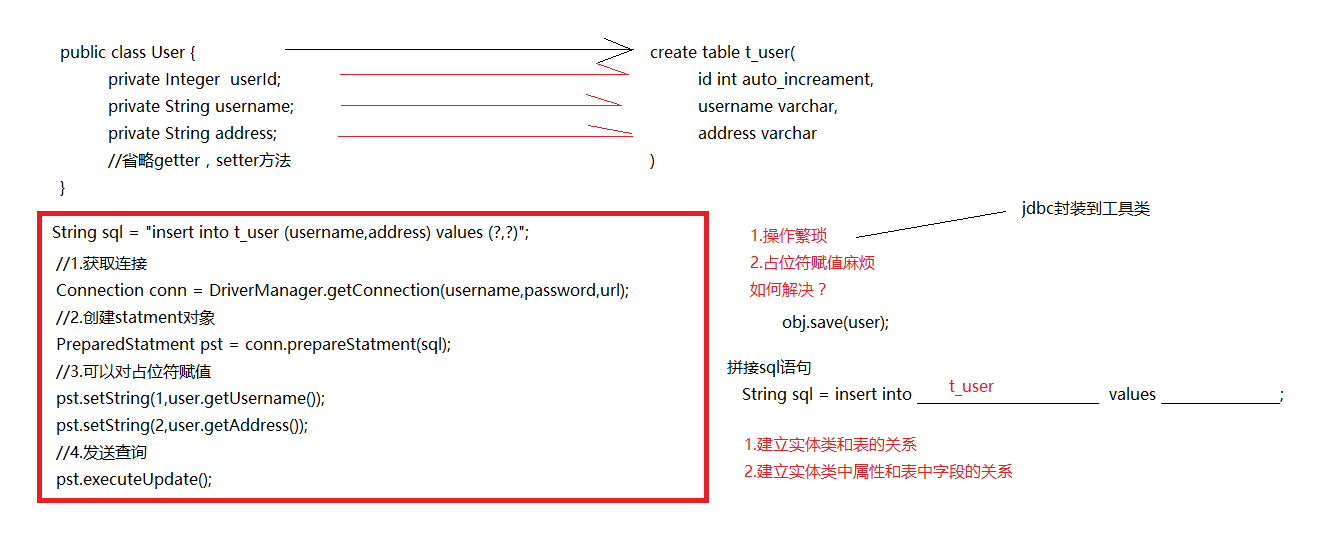
2、JDBC问题解决思路
-
操作繁琐 就将jdbc封装到工具类
-
占位符值麻烦
1.?建立实体类和表的关系
2.?建立实体类中属性和表中字段的关系
3、ORM思想
-
ORM(Object-Relational Mapping) 表示对象关系映射。在面向对象的软件开发中,通过ORM,就可以把对象映射到关系型数据库中。只要有一套程序能够做到建立对象与数据库的关联,操作对象就可以直接操作数据库数据,就可以说这套程序实现了ORM对象关系映射
-
简单的说:ORM就是建立实体类和数据库表之间的关系,从而达到操作实体类就相当于操作数据库表的目的。
-
主要目的: 操作实体类就相当于操作数据库表
-
建立两个映射关系:
实体类和表的映射关系 实体类中属性和表中字段的映射关系 -
当实现一个应用程序时(不使用O/R Mapping),我们可能会写特别多数据访问层的代码,从数据库保存数据、修改数据、删除数据,而这些代码都是重复的。而使用ORM则会大大减少重复性代码。对象关系映射(Object Relational Mapping,简称ORM),主要实现程序对象到关系数据库数据的映射。
-
实现ORM的框架:Mybatis,Hirbernate
二、实现ORM思想的框架Hirbernate介绍
-
Hibernate是一个开放源代码的对象关系映射框架
-
它对JDBC进行了非常轻量级的对象封装,
-
它将POJO(java实体类对象)与数据库表建立映射关系,是一个全自动的orm框架
-
hibernate可以自动生成SQL语句,自动执行,使得Java程序员可以随心所欲的使用对象编程思维来操纵数据库。
三、JPA规范
JPA的全称是Java Persistence API, 即Java 持久化API,是SUN公司推出的一套基于ORM的规范,内部是由一系列的接口和抽象类构成。
JPA通过JDK 5.0注解描述对象-关系表的映射关系,并将运行期的实体对象持久化到数据库中。
-
JPA是一套规范,实现JPA规范,内部由接口和抽象类组成
-
JDBC规范和JPA规范比较
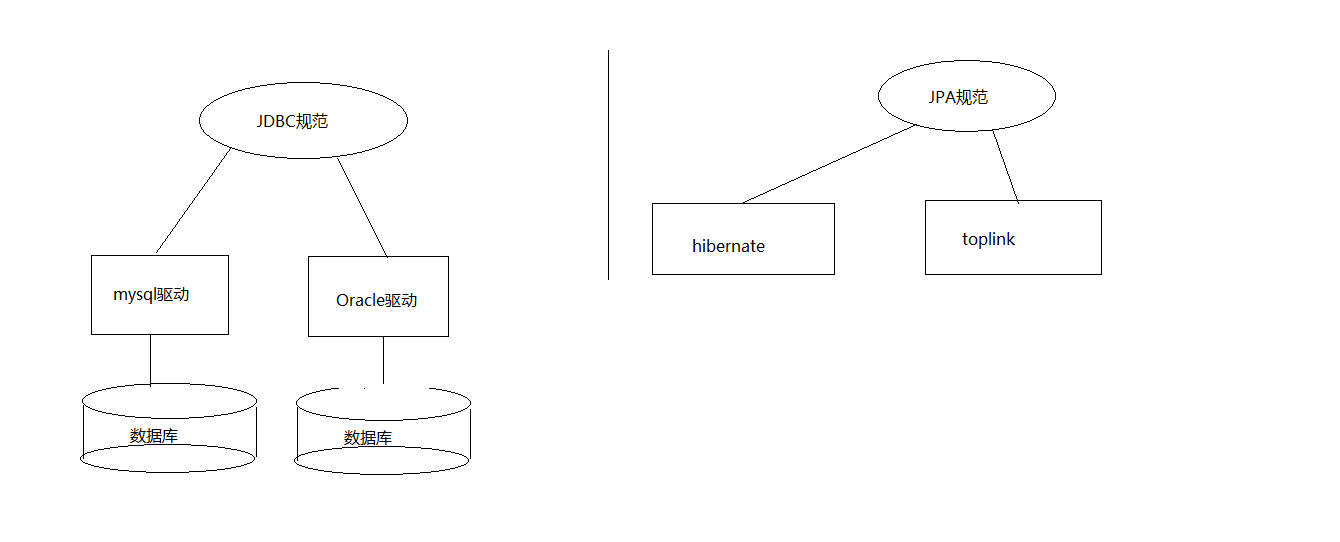
四、JPA的基本操作(CRUD)
1、案例:添加一个客户到数据库的客户表中。
-
客户:就是一家公司
2、搭建环境
(1)创建maven工程导入依赖
-
创建项目jpa_basic
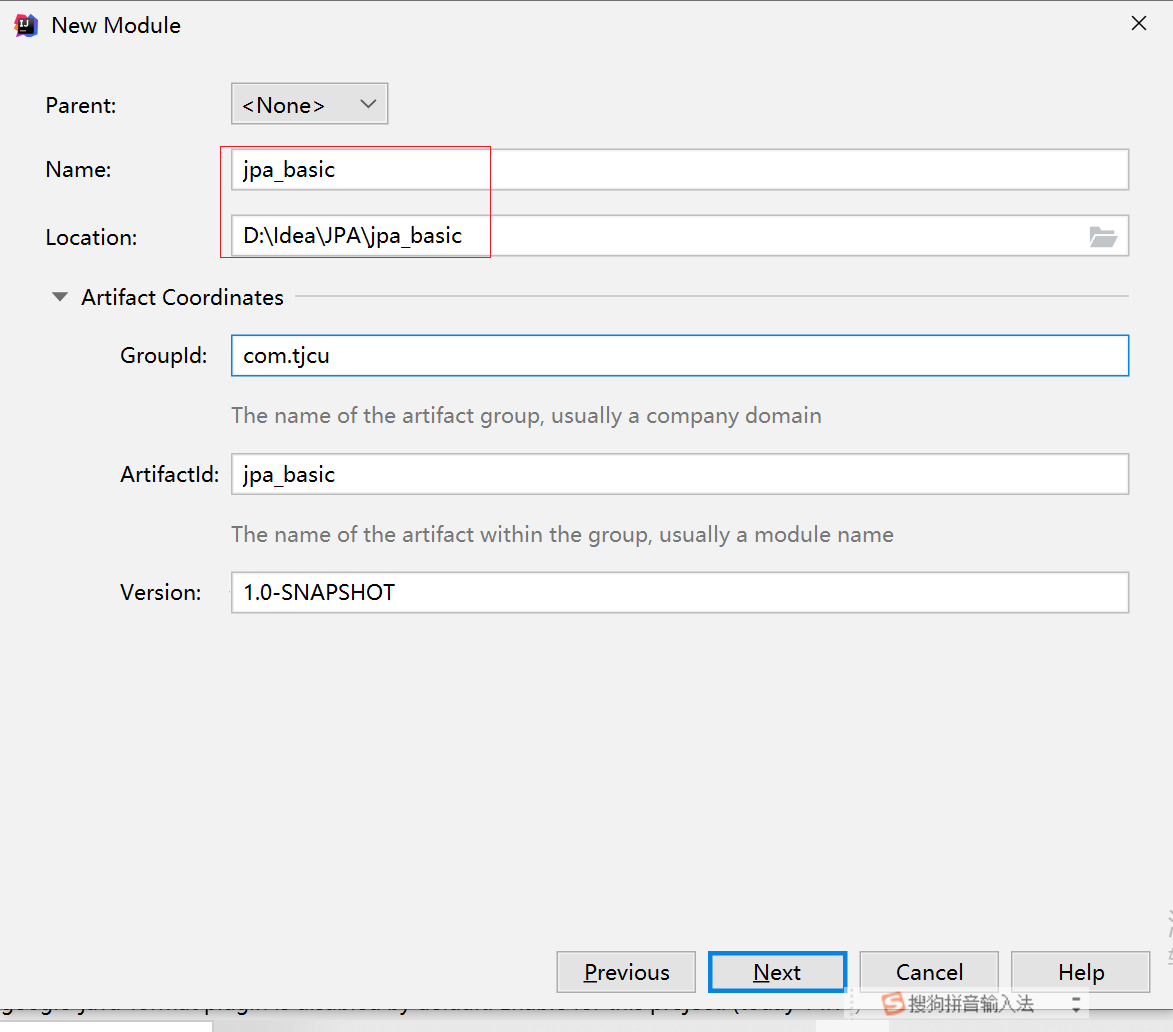
-
导入依赖
由于JPA是sun公司制定的API规范,所以我们不需要导入额外的JPA相关的jar包,只需要导入JPA的提供商的jar包。我们选择Hibernate作为JPA的提供商,所以需要导入Hibernate的相关jar包。
??<properties>
????????<project.build.sourceEncoding>UTF-8</project.build.sourceEncoding>
????????<maven.compiler.source>1.8</maven.compiler.source>
????????<maven.compiler.target>1.8</maven.compiler.target>
????????<project.hibernate.version>5.0.7.Final</project.hibernate.version>
????</properties>
????<dependencies>
????????<!--?junit?-->
????????<dependency>
????????????<groupId>junit</groupId>
????????????<artifactId>junit</artifactId>
????????????<version>4.12</version>
????????????<scope>test</scope>
????????</dependency>
????????<!--?hibernate对jpa的支持包?-->
????????<dependency>
????????????<groupId>org.hibernate</groupId>
????????????<artifactId>hibernate-entitymanager</artifactId>
????????????<version>${project.hibernate.version}</version>
????????</dependency>
????????<!--?c3p0?-->
????????<dependency>
????????????<groupId>org.hibernate</groupId>
????????????<artifactId>hibernate-c3p0</artifactId>
????????????<version>${project.hibernate.version}</version>
????????</dependency>
????????<!--?log日志?-->
????????<dependency>
????????????<groupId>log4j</groupId>
????????????<artifactId>log4j</artifactId>
????????????<version>1.2.17</version>
????????</dependency>
????????<!--?Mysql?and?MariaDB?-->
????????<dependency>
????????????<groupId>mysql</groupId>
????????????<artifactId>mysql-connector-java</artifactId>
????????????<version>8.0.27</version>
????????</dependency>
????</dependencies>
(2)需要配置jpa的核心配置文件
-
配置到类路径下的一个叫做META-INF的文件夹下
-
创建文件吗,命名:persistence.xml
-
导入约束 选择约束模板
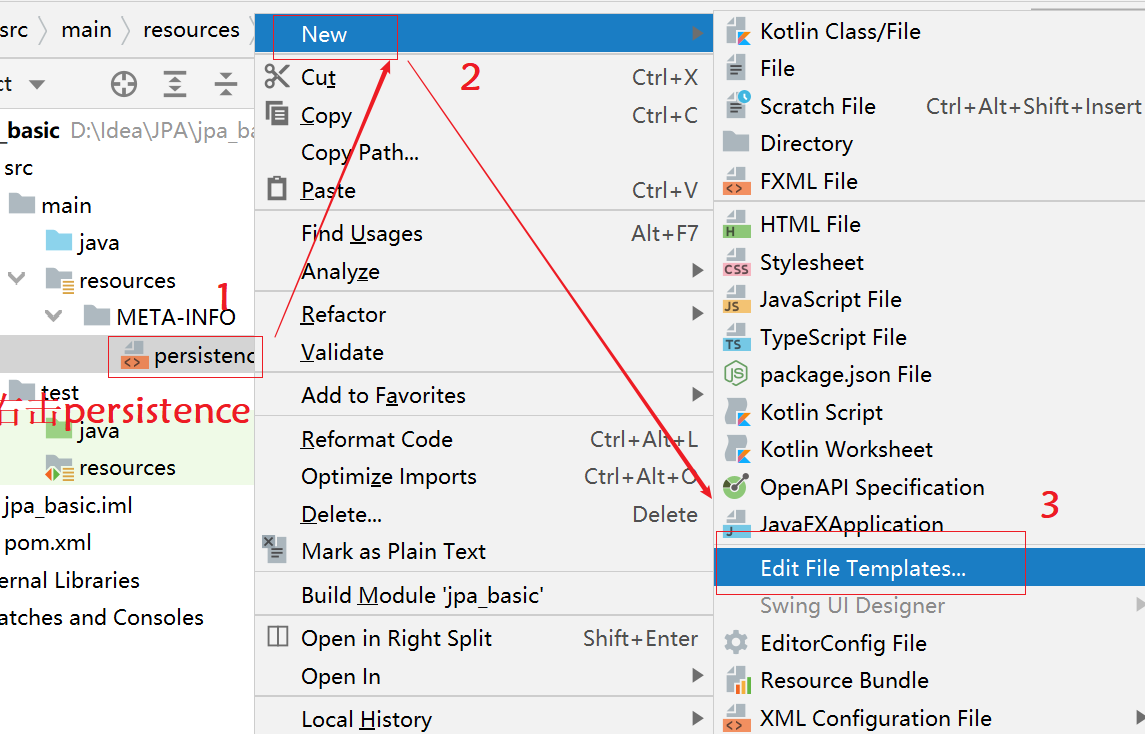
选择persistence_2.xml版本
将模板的约束复制放入MEAT_INFO文件下的persistence.xml中
<?xml?version="1.0"?encoding="UTF-8"?>
<persistence?xmlns="http://java.sun.com/xml/ns/persistence"?version="2.0">
</persistence>

-
配置persistence-unit节点(持久化单元)
-?name:持久化单元名称
-?transaction-type:事务管理方式
????????????????Jta:分布式事务管理
????????????????Resource_Local:本地事务管理
-?Provider:jpa的实现方式
-?数据库信息
-?可选配置:配置jpa实现方式的配置信息
<?xml?version="1.0"?encoding="UTF-8"?>
<persistence?xmlns="http://java.sun.com/xml/ns/persistence"?version="2.0">
<!--1.配置persistence-unit节点(持久化单元)
?????transaction-type:事务管理方式
????????????????Jta:分布式事务管理
????????????????Resource_Local:本地事务管理
-->
????<persistence-unit?name="my_jpa"?transaction-type="RESOURCE_LOCAL">
????<!--jpa的实现方式-->
????<!--数据库信息-->
????<!--可选配置,配置jpa实现方的配置信息-->
????</persistence-unit>
</persistence>
(3)编写客户数据库表(cust_customer)和实体类(customer)
-
顾客的数据库表
CREATE?TABLE?cust_customer?(
??cust_id?BIGINT?(?32?)?NOT?NULL?AUTO_INCREMENT?COMMENT?'客户编号(主键)',
??cust_name?VARCHAR?(?32?)?NOT?NULL?COMMENT?'客户名称(公司名称)',
??cust_source?VARCHAR?(?32?)?DEFAULT?NULL?COMMENT?'客户信息来源',
??cust_industry?VARCHAR?(?32?)?DEFAULT?NULL?COMMENT?'客户所属行业',
??cust_level?VARCHAR?(?32?)?DEFAULT?NULL?COMMENT?'客户级别',
??cust_address?VARCHAR?(?128?)?DEFAULT?NULL?COMMENT?'客户联系地址',
??cust_phone?VARCHAR?(?64?)?DEFAULT?NULL?COMMENT?'客户联系电话',
??PRIMARY?KEY?(?`cust_id`?)?
)?ENGINE?=?INNODB?AUTO_INCREMENT?=?1?DEFAULT?CHARSET?=?utf8;
-
实体类(customer)并配置实体类和表,类中的属性和表字段成一一对应关系
/**
?*?@author?王恒杰
?*?@date?2022/2/21?9:47
?*?@Description:
?*/
@Entity?????//声明实体类
@Table(name?=?"cust_customer")????//建立实体类和表的映射关系
public?class?Customer?implements?Serializable?{
????@Id??//声明私有属性为主键
????@GeneratedValue(strategy=?GenerationType.IDENTITY)?//配置主键的生成策略
????@Column(name?=?"cust_id")
????private?Long?custId;
????@Column(name?=?"cust_name")
????private?String?custName;
????@Column(name?=?"custSource")
????private?String?custSource;
????@Column(name?=?"cust_industry")
????private?String?custIndustry;
????@Column(name?=?"cust_level")
????private?String?custLevel;
????@Column(name="cust_Address")
????private?String?custAddress;
????@Column(name="cust_phone")
????private?String?custPhone;
????public?Customer()?{
????}
????public?Customer(Long?custId,?String?custName,?String?custSource,?String?custIndustry,?String?custLevel,?String?custAddress,?String?custPhone)?{
????????this.custId?=?custId;
????????this.custName?=?custName;
????????this.custSource?=?custSource;
????????this.custIndustry?=?custIndustry;
????????this.custLevel?=?custLevel;
????????this.custAddress?=?custAddress;
????????this.custPhone?=?custPhone;
????}
????public?Long?getCustId()?{
????????return?custId;
????}
????public?void?setCustId(Long?custId)?{
????????this.custId?=?custId;
????}
????public?String?getCustName()?{
????????return?custName;
????}
????public?void?setCustName(String?custName)?{
????????this.custName?=?custName;
????}
????public?String?getCustSource()?{
????????return?custSource;
????}
????public?void?setCustSource(String?custSource)?{
????????this.custSource?=?custSource;
????}
????public?String?getCustIndustry()?{
????????return?custIndustry;
????}
????public?void?setCustIndustry(String?custIndustry)?{
????????this.custIndustry?=?custIndustry;
????}
????public?String?getCustLevel()?{
????????return?custLevel;
????}
????public?void?setCustLevel(String?custLevel)?{
????????this.custLevel?=?custLevel;
????}
????public?String?getCustAddress()?{
????????return?custAddress;
????}
????public?void?setCustAddress(String?custAddress)?{
????????this.custAddress?=?custAddress;
????}
????public?String?getCustPhone()?{
????????return?custPhone;
????}
????public?void?setCustPhone(String?custPhone)?{
????????this.custPhone?=?custPhone;
????}
????@Override
????public?String?toString()?{
????????return?"Customer{"?+
????????????????"custId="?+?custId?+
????????????????",?custName='"?+?custName?+?'\''?+
????????????????",?custSource='"?+?custSource?+?'\''?+
????????????????",?custIndustry='"?+?custIndustry?+?'\''?+
????????????????",?custLevel='"?+?custLevel?+?'\''?+
????????????????",?custAddress='"?+?custAddress?+?'\''?+
????????????????",?custPhone='"?+?custPhone?+?'\''?+
????????????????'}';
????}
}
(5)配置JPA的核心配置文件
在java工程的src路径下创建一个名为META-INF的文件夹,在此文件夹下创建一个名为persistence.xml的配置文件
<?xml?version="1.0"?encoding="UTF-8"?>
<persistence?xmlns="http://java.sun.com/xml/ns/persistence"?version="2.0">
????<!--1.配置persistence-unit节点(持久化单元)
?????????transaction-type:事务管理方式
????????????????????Jta:分布式事务管理
????????????????????Resource_Local:本地事务管理
????-->
????<persistence-unit?name="myJpa"?transaction-type="RESOURCE_LOCAL">
????????<!--jpa的实现方式?配置JPA规范的服务提供商?-->
????????<provider>org.hibernate.jpa.HibernatePersistenceProvider</provider>
????????<!--数据库信息-->
????????<properties>
????????????<!--数据库驱动-->
????????????<property?name="javax.persistence.jdbc.driver"?value="com.mysql.cj.jdbc.Driver"/>
????????????<!--数据库地址-->
????????????<property?name="javax.persistence.jdbc.url"
??????????????????????value="jdbc:mysql://localhost:3306/customer?serverTimezone=UTC"/>
????????????<!--数据库名-->
????????????<property?name="javax.persistence.jdbc.user"?value="root"/>
????????????<!--数据库密码-->
????????????<property?name="javax.persistence.jdbc.password"?value="root"/>
????????????<!--可选配置,配置jpa实现方的配置信息-->
????????????<!--配置jpa实现方(hibernate)的配置信息
????????显示sql???????????:???false|true
????????自动创建数据库表????:??hibernate.hbm2ddl.auto
????????????????create??????:?程序运行时创建数据库表(如果有表,先删除表再创建)
????????????????update??????:程序运行时创建表(如果有表,不会创建表)
????????????????none????????:不会创建表
????-->
????????????<property?name="hibernate.show_sql"?value="true"/>
????????????<property?name="hibernate.hbm2ddl.auto"?value="update"/>
????????</properties>
????</persistence-unit>
</persistence>
(6)测试类·实现添加操作
/**
?*?@author?王恒杰
?*?@date?2022/2/21?11:32
?*?@Description:
?*/
public?class?InsertCustomerTest{
????public?static?void?main(String[]?args)?{
????????/**
?????????*?创建实体管理类工厂,借助Persistence的静态方法获取
?????????*?????其中传递的参数为持久化单元名称,需要jpa配置文件中指定
?????????*/
????????EntityManagerFactory?factory?=?Persistence.createEntityManagerFactory("myJpa");
????????//创建实体管理类
????????EntityManager?em?=?factory.createEntityManager();
????????//获取事务对象
????????EntityTransaction?tx?=?em.getTransaction();
????????//开启事务
????????tx.begin();
????????Customer?c?=?new?Customer();
????????c.setCustName("王恒杰");
????????c.setCustAddress("天津商业大学");
????????c.setCustPhone("15120308630");
????????//保存操作
????????em.persist(c);
????????//提交事务
????????tx.commit();
????????//释放资源
????????em.close();
????????factory.close();
????}
}

五、JPA中的主键生成策略
通过annotation(注解)来映射hibernate实体的,基于annotation的hibernate主键标识为@Id, 其生成规则由@GeneratedValue(生成值)设定的.这里的@id和@GeneratedValue都是JPA的标准用法。
JPA提供的四种标准用法为TABLE,SEQUENCE(sequence),IDENTITY(identity),AUTO(auto)。
具体说明如下:
1、IDENTITY:主键由数据库自动生成(主要是自动增长型)
用法:
????@Id??//声明私有属性为主键
????@GeneratedValue(strategy=?GenerationType.IDENTITY)?//配置主键的生成策略
????@Column(name?=?"cust_id")
????private?Long?custId;
2、SEQUENCE:根据底层数据库的序列来生成主键,条件是数据库支持序列。
用法:
????@Id??
????@GeneratedValue(strategy?=?GenerationType.SEQUENCE,generator="payablemoney_seq")??
????@SequenceGenerator(name="payablemoney_seq",?sequenceName="seq_payment")??
????private?Long?custId;
????//@SequenceGenerator源码中的定义
????@Target({TYPE,?METHOD,?FIELD})???
????@Retention(RUNTIME)??
????public?@interface?SequenceGenerator?{??
???????//表示该表主键生成策略的名称,它被引用在@GeneratedValue中设置的“generator”值中
???????String?name();??
???????//属性表示生成策略用到的数据库序列名称。
???????String?sequenceName()?default?"";??
???????//表示主键初识值,默认为0
???????int?initialValue()?default?0;??
???????//表示每次主键值增加的大小,例如设置1,则表示每次插入新记录后自动加1,默认为50
???????int?allocationSize()?default?50;??
????}
3、AUTO:主键由程序控制
用法:
@Id??
????@GeneratedValue(strategy?=?GenerationType.AUTO)??
????private?Long?custId;
4、TABLE:使用一个特定的数据库表格来保存主键
用法:
@Id??
????@GeneratedValue(strategy?=?GenerationType.TABLE,?generator="payablemoney_gen")??
????@TableGenerator(name?=?"pk_gen",??
????????table="tb_generator",??
????????pkColumnName="gen_name",??
????????valueColumnName="gen_value",??
????????pkColumnValue="PAYABLEMOENY_PK",??
????????allocationSize=1??
????)?
private?Long?custId;
//@TableGenerator的定义:
????@Target({TYPE,?METHOD,?FIELD})???
????@Retention(RUNTIME)??
????public?@interface?TableGenerator?{??
??????//表示该表主键生成策略的名称,它被引用在@GeneratedValue中设置的“generator”值中
??????String?name();??
??????//表示表生成策略所持久化的表名,例如,这里表使用的是数据库中的“tb_generator”。
??????String?table()?default?"";??
??????//catalog和schema具体指定表所在的目录名或是数据库名
??????String?catalog()?default?"";??
??????String?schema()?default?"";??
??????//属性的值表示在持久化表中,该主键生成策略所对应键值的名称。例如在“tb_generator”中将“gen_name”作为主键的键值
??????String?pkColumnName()?default?"";??
??????//属性的值表示在持久化表中,该主键当前所生成的值,它的值将会随着每次创建累加。例如,在“tb_generator”中将“gen_value”作为主键的值?
??????String?valueColumnName()?default?"";??
??????//属性的值表示在持久化表中,该生成策略所对应的主键。例如在“tb_generator”表中,将“gen_name”的值为“CUSTOMER_PK”。?
??????String?pkColumnValue()?default?"";??
??????//表示主键初识值,默认为0。?
??????int?initialValue()?default?0;??
??????//表示每次主键值增加的大小,例如设置成1,则表示每次创建新记录后自动加1,默认为50。
??????int?allocationSize()?default?50;??
??????UniqueConstraint[]?uniqueConstraints()?default?{};??
????}?
????//这里应用表tb_generator,定义为?:
????CREATE?TABLE??tb_generator?(??
??????id?NUMBER?NOT?NULL,??
??????gen_name?VARCHAR2(255)?NOT?NULL,??
??????gen_value?NUMBER?NOT?NULL,??
??????PRIMARY?KEY(id)??
????)
六、JPA的API介绍
1、 Persistence对象
Persistence对象主要作用是用于获取EntityManagerFactory对象的 。通过调用该类的createEntityManagerFactory静态方法,根据配置文件中持久化单元名称创建EntityManagerFactory。
????@Test
????public?void?test(){
????????/**
?????????*?1、创建EntityManagerFactory
?????????*/
????????String?unitName="myJpa";
????????EntityManagerFactory?entityManagerFactory?=?Persistence.createEntityManagerFactory(unitName);
????}
2、EntityManagerFactory
EntityManagerFactory 接口主要用来创建 EntityManager 实例
??/**
?????????*?2、创建实体管理类
?????????*?EntityManagerFactory?接口主要用来创建?EntityManager?实例
?????????*/
????????EntityManager?entityManager?=?entityManagerFactory.createEntityManager();
注意: 由于EntityManagerFactory 是一个线程安全的对象(即多个线程访问同一个EntityManagerFactory 对象不会有线程安全问题),并且EntityManagerFactory 的创建极其浪费资源,所以在使用JPA编程时,我们可以对EntityManagerFactory的创建进行优化,只需要做到一个工程只存在一个EntityManagerFactory 即可
3、EntityManager
在 JPA 规范中, EntityManager是完成持久化操作的核心对象。实体类作为普通 java对象,只有在调用 EntityManager将其持久化后才会变成持久化对象。EntityManager对象在一组实体类与底层数据源之间进行 O/R 映射的管理。它可以用来管理和更新 Entity Bean, 根椐主键查找 Entity Bean, 还可以通过JPQL语句查询实体。
我们可以通过调用EntityManager的方法完成获取事务,以及持久化数据库的操作
方法说明:
??GetTransaction?:?获取事务对象
??Persist?:?保存操作
??Merge?:?更新操作
??Remove?:?删除操作
??Find/GetReference?:?根据id查询
-
实现代码
?/**
?????????*?3、entityManager相关操作
?????????*
?????????*???1.GetTransaction?:?获取事务对象
?????????*???2.Persist(坚持)?:?保存操作
?????????*???3.Merge?(合并):?更新操作
?????????*???4.Remove(删除)?:?删除操作
?????????*???5.Find/GetReference(查找/获取引用)?:?根据id查询
?????????*/
????????//获取事务对象
????????EntityTransaction?transaction?=?entityManager.getTransaction();
????????//开启事务
????????transaction.begin();
????????//提交事务·
????????transaction.commit();
????????//回滚事务
????????transaction.rollback();
????????
????????//添加操作
????????entityManager.persist();
????????//更新操作
????????entityManager.merge();
????????//删除操作
????????entityManager.remove();
????????//查询操作
????????entityManager.find();
4、EntityTransaction
在 JPA 规范中, EntityTransaction是完成事务操作的核心对象,对于EntityTransaction在我们的java代码中承接的功能比较简单
?????//获取事务对象
????????EntityTransaction?transaction?=?entityManager.getTransaction();
????????//开启事务
????????transaction.begin();
????????//提交事务·
????????transaction.commit();
????????//回滚事务
????????transaction.rollback();
七、JPA的工具类 JpaUtil
1、工具类JpaUtil
/**
?*?@author?王恒杰
?*?@date?2022/2/21?13:19
?*?@Description:
?*/
public?class?JpaUtil?{
????/**
?????*?Jpa的实体类管理工具:相当于Hirbernate的SessionFactory
?????*/
????private?static??EntityManagerFactory?em;
????//静态代码块赋值
????static?{
????????//注意:该方法参数必须和persistence.xml中persistence-unit标签name属性取值一致
???????em?=?Persistence.createEntityManagerFactory("myJpa");
????}
????/**
?????*?使用管理器工厂生产一个管理器对象
?????*?@return???管理器对象
?????*/?
????public?static?EntityManager?getEntityManager()?{
????????EntityManager?entityManager?=?em.createEntityManager();
????????return?entityManager;
????}
}
2、使用工具类实现添加操作
?/**
?????*?使用工具类实现添加操作
?????*/
????@Test
????public?void?test()?{
????????//1.获取事务对象
????????EntityManager?entityManager?=?JpaUtil.getEntityManager();
????????EntityTransaction?transaction?=?entityManager.getTransaction();
????????//2.开启事务
????????transaction.begin();
????????Customer?customer?=?new?Customer(null,?"天津以琳快讯科技有限公司",?"58同城",?"IT行业",?"1级别",?"古城创业大厦",?"123456");
????????//3.添加操作
????????entityManager.persist(customer);
????????//4.提交事务·
????????transaction.commit();
????????//5.关闭资源
????????entityManager.close();
????}
-
底层实现的Sql语句
insert?into?
cust_customer?
(cust_Address,?cust_industry,?cust_level,?cust_name,?cust_phone,?custSource)?
values?(?,??,??,??,??,??)

八、使用JPA完成增删改查操作
1、添加数据
/**
?*?@author?王恒杰
?*?@date?2022/2/21?10:13
?*?@Description:
?*/
public?class?JpaTest?{
????/**
?????*?使用工具类实现添加操作
?????*/
????@Test
????public?void?InsertCustomer()?{
????????//1.获取事务对象
????????EntityManager?entityManager?=?JpaUtil.getEntityManager();
????????EntityTransaction?transaction?=?entityManager.getTransaction();
????????//2.开启事务
????????transaction.begin();
????????Customer?customer?=?new?Customer(null,?"天津商业大学",?"今日校园",?"教育",?"、特殊级别",?"天津北辰天穆镇",?"8888888");
????????//3.添加操作
????????entityManager.persist(customer);
????????//4.提交事务·
????????transaction.commit();
????????//5.关闭资源
????????entityManager.close();
????}
}
-
底层实现Sql语句
insert?into
?cust_customer?
?(cust_Address,?cust_industry,?cust_level,?cust_name,?cust_phone,?cust_Source)?
?values?(?,??,??,??,??,??)
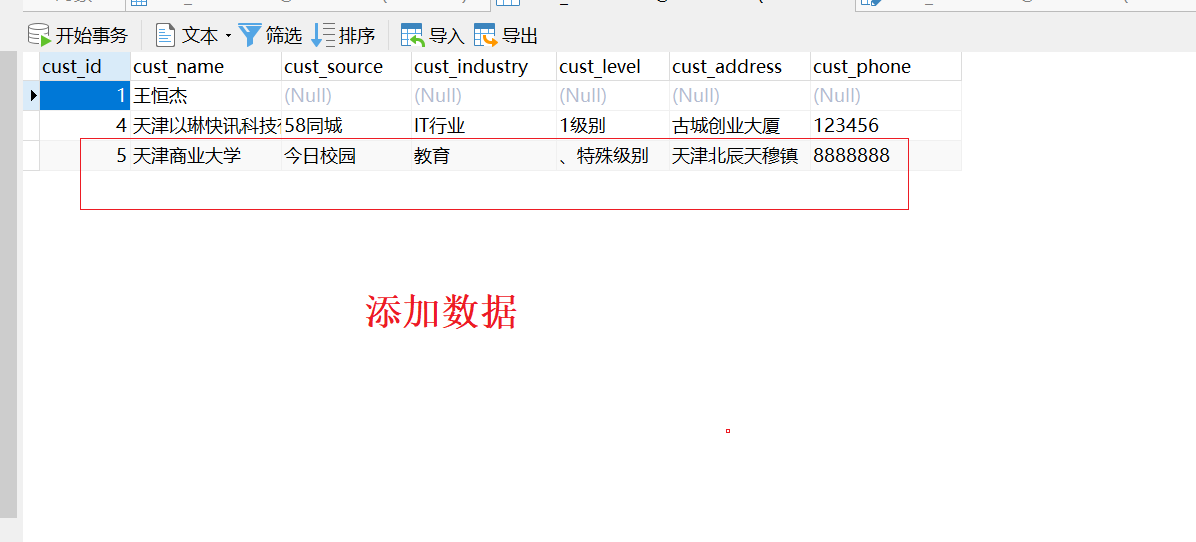
2、修改数据(先查询出来再修改)
??/**
?????*?修改数据
?????*/
????@Test
????public?void?update()?{
????????//1.?获取实体类管理器
????????EntityManager?entityManager?=?JpaUtil.getEntityManager();
????????//获取事务
????????EntityTransaction?transaction?=?entityManager.getTransaction();
????????//开启事务
????????transaction.begin();
????????//查询出来需要修改的数据??id=5
????????Customer?customer?=?entityManager.find(Customer.class,?5L);
????????//?修改id=5?的顾客?地址为贵州省遵义市播州区
????????customer.setCustAddress("贵州省遵义市播州区");
????????//修改数据
????????Customer?merge?=?entityManager.merge(customer);
????????System.out.println("数据修改成功后数据"?+?merge);
????????//??提交事务
????????transaction.commit();
????????//关闭链接
????????entityManager.close();
????}
-
底层实现的SQL语句
update?cust_customer?
set?cust_Address=?,?cust_industry=?,?cust_level=?,?cust_name=?,?cust_phone=?,?cust_Source=??
where?cust_id=?

3、查询数据
(1)根据id查询,使用立即加载的策略
????@Test
????public?void?selectCustomerById(){
????????EntityManager?entityManager?=?JpaUtil.getEntityManager();
????????EntityTransaction?transaction?=?entityManager.getTransaction();
????????transaction.begin();
????????//查询id=5的顾客
????????Customer?customer?=?entityManager.find(Customer.class,?5l);
????????System.out.println(customer);
????}

(2)查询实体的缓存问题
???@Test
????public?void?selectCustomerById()?{
????????EntityManager?entityManager?=?JpaUtil.getEntityManager();
????????EntityTransaction?transaction?=?entityManager.getTransaction();
????????transaction.begin();
????????//查询id=5的顾客
????????Customer?customer1?=?entityManager.find(Customer.class,?5l);
????????Customer?customer2?=?entityManager.find(Customer.class,?5l);
????????//?输出结果是true,EntityManager也有缓存
????????System.out.println(customer1==customer2);
????}

(3)延迟加载策略的方法:Reference
???@Test
????public?void?selectCustomerByIdAndReference()?{
????????EntityManager?entityManager?=?JpaUtil.getEntityManager();
????????EntityTransaction?transaction?=?entityManager.getTransaction();
????????transaction.begin();
????????//查询id=5的顾客
????????Customer?customer1?=?entityManager.getReference(Customer.class,5L);
????????//?输出结果是true,EntityManager也有缓存
????????System.out.println(customer1);
????}
4、删除数据
????/**
?????*?删除数据
?????*/
????@Test
????public?void?deleteCustomer()?{
????????EntityManager?entityManager?=?JpaUtil.getEntityManager();
????????EntityTransaction?transaction?=?entityManager.getTransaction();
????????transaction.begin();
????????//查询id=5的顾客
????????Customer?customer=?entityManager.getReference(Customer.class,?5L);
????????//删除
????????entityManager.remove(customer);
????????//提交事务
????????transaction.commit();
????????//关闭资源
????????entityManager.close();
????}
-
实现Sql语句
delete?from?cust_customer?where?cust_id=?